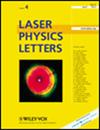Thermal conductivity analysis of nanofluid through laser speckle method
IF 1.4
4区 物理与天体物理
Q3 OPTICS
引用次数: 0
Abstract
The significance of laser interaction in assessing the stability of colloidal CeO2 nanoparticles (NPs) in water medium is highlighted in this study. Utilizing the laser speckle technique, a non-destructive optical method, the activities of NPs synthesized in continuous wave (CW) mode are examined. The size of the cerium oxide NPs is determined through Particle Size Analyzer technique. The fluctuation in intensity of laser speckle scattered from various particles reflects the configuration of NPs in the base fluid medium, offering valuable insights into their stability. Further confirmation of NP stability is obtained through UV–Visible absorption spectroscopy. The examination of CeO2 NPs in deionized water is conducted with a CW mode He–Ne laser operating at 632 nm. This laser interaction approach proves to be instrumental in evaluating the thermal properties of the prepared samples, particularly the thermal conductivity, which shows enhancements at varying concentrations and temperatures. The findings demonstrate the potential of fabricating CeO2-water nanofluids with improved thermal conductivity through laser interaction in a liquid medium, thereby eliminating the need for hazardous chemicals and vacuum conditions. This suggests promising applications in medium-temperature scenarios.通过激光斑点法分析纳米流体的导热性
本研究强调了激光相互作用在评估胶体 CeO2 纳米粒子(NPs)在水介质中稳定性方面的重要意义。利用激光斑点技术(一种非破坏性光学方法)检测了以连续波(CW)模式合成的 NPs 的活性。氧化铈 NPs 的尺寸是通过粒度分析仪技术测定的。从不同颗粒散射出的激光斑点的强度波动反映了 NPs 在基液介质中的构型,为了解其稳定性提供了宝贵的信息。紫外可见吸收光谱进一步证实了 NP 的稳定性。对去离子水中 CeO2 NPs 的检测是使用波长为 632 nm 的 CW 模式氦氖激光器进行的。事实证明,这种激光相互作用方法有助于评估所制备样品的热性能,特别是热导率,在不同浓度和温度下,热导率都有所提高。研究结果表明,通过激光在液体介质中的相互作用,可以制备出热导率更高的 CeO2-水纳米流体,从而无需使用危险化学品和真空条件。这表明在中温环境下的应用前景广阔。
本文章由计算机程序翻译,如有差异,请以英文原文为准。
求助全文
约1分钟内获得全文
求助全文
来源期刊

Laser Physics Letters
物理-仪器仪表
CiteScore
3.30
自引率
11.80%
发文量
174
审稿时长
2.4 months
期刊介绍:
Laser Physics Letters encompasses all aspects of laser physics sciences including, inter alia, spectroscopy, quantum electronics, quantum optics, quantum electrodynamics, nonlinear optics, atom optics, quantum computation, quantum information processing and storage, fiber optics and their applications in chemistry, biology, engineering and medicine.
The full list of subject areas covered is as follows:
-physics of lasers-
fibre optics and fibre lasers-
quantum optics and quantum information science-
ultrafast optics and strong-field physics-
nonlinear optics-
physics of cold trapped atoms-
laser methods in chemistry, biology, medicine and ecology-
laser spectroscopy-
novel laser materials and lasers-
optics of nanomaterials-
interaction of laser radiation with matter-
laser interaction with solids-
photonics
 求助内容:
求助内容: 应助结果提醒方式:
应助结果提醒方式:


